Table of Contents
The days when you only knew peanut or other nut butters from American movies are long gone. Now it’s common to have at least one kind of delicious butter at home, tempting you to grab a spoon and go for a scoop once, twice or even three times. Sometimes you don’t even think about it and you’re already scraping the bottom, not knowing how you got there so quickly. And what is it that makes them so wickedly good? We’ll discuss that and much more in today’s article.
What is nut butter and how is it produced?
Although it is commonly called butter, it is basically a cream that is made from nuts. On one side you have the crunchy nuts and on the other you have a smooth, almost liquid cream. The raw material is the same, but the consistency couldn’t be more different. It is no miracle, but pure mechanical power in the form of a powerful blender. In fact, the nuts contain approximately 50% fat, which is released when they are ground. The longer the blending is carried out, the more is released and the more liquid the cream becomes. This is how you can imagine the processing process in its most basic form. However, the production of nut butters is often accompanied by other processes such as peeling, roasting or adding other ingredients depending on the type of product. [1]
What are the different types of nut butters?
Navigating the world of nut creams is no mean feat. There are countless options on the market today. Depending on their ingredients profile, we can classify them into single, multi-type, protein and flavoured. But they also differ in consistency, which can be smooth or crunchy. In this respect, peanut butter lovers are divided into two irreconcilable camps. Some can’t get enough of the creamy, almost liquid texture of the smooth butter, and others don’t understand how anyone can enjoy it to the max without the crunchy bits.
How do we classify nut butters by their consistency?
Smooth nut butter: has a soft, more fluid texture that spreads easily.
- Crunchy nut butter: it has chunks of crunchy nuts mixed into the soft cream, which are added to the churned butter. The other way of making it is that the nuts are not blended completely smooth and pieces remain in the cream. [1]
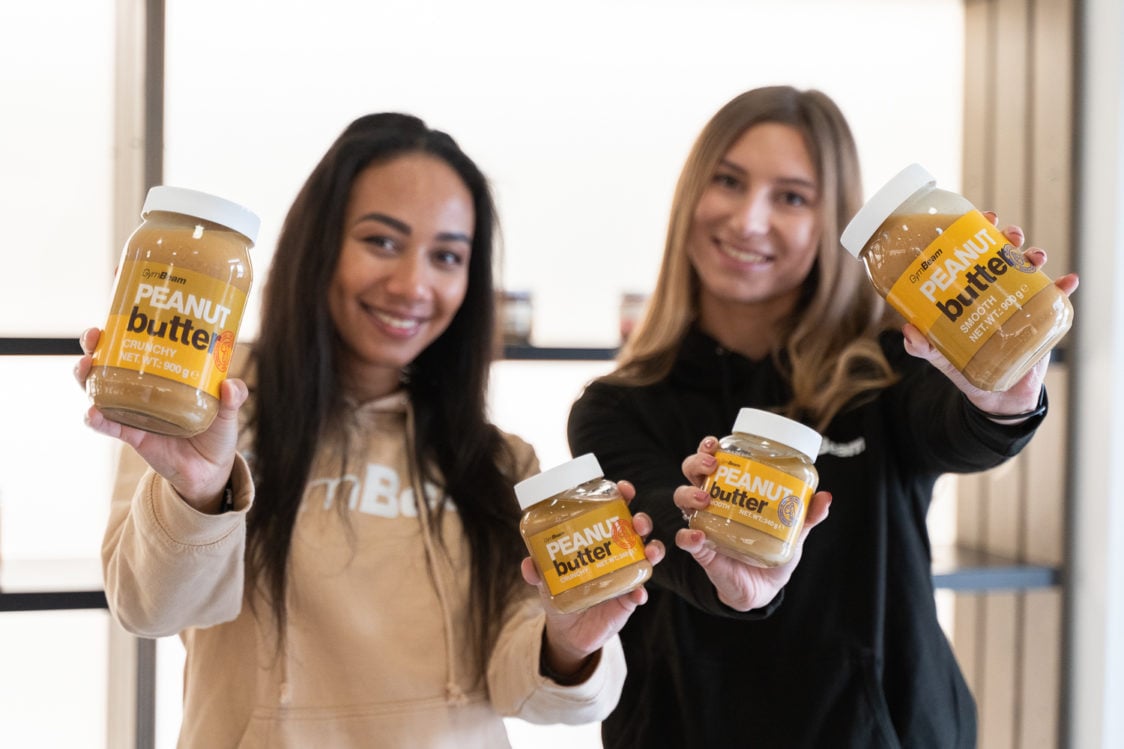
How do you classify nut butters by their ingredients profile?
1. One type nut butters
You can recognise them by the fact that they have only one ingredient in their ingredients list. For example, they contain 100 % peanuts, cashews, almonds, coconut or other nuts. These give the product a natural nutty flavour and quality nutrients, including vitamins and minerals, with many benefits. In addition, they contain no flavourings (sugar, salt, palm oil) or other additives. This makes them one of the most nutritionally valuable nut creams and the best choice for anyone who wants to get the most out of these crunchy little morsels.
2. Multi-type nut butters
Unlike the single-type ones, they have several types of nuts in their ingredients list. However, there should still be no flavourings or other additives. Combining several types of nuts can result in unique flavour combinations. They also offer a more diverse range of vitamins, minerals and other nutrients than single types. An example is triple nut butter, which contains a mix of peanuts, cashews and almonds. A combination of almonds or cashews with coconut is also popular.
3. Protein nut butters
These nut creams are enriched with protein, so they contain more protein and usually less fat. Thus, you will commonly find whey protein in the ingredients, which is popular for its optimal ratio of amino acids. These are the basic building blocks for muscle growth, and so give these creams an added value that is appreciated not only by strength athletes. More scarce are pure vegetable protein spreads, which have, for example, rice or pea protein isolate in their composition.
Protein butters are thus easier to fit into the diet of people who watch their protein intake while limiting fat. However, if you put 30 g of this cream in your porridge, you increase its protein content by about 5 g. This is not a major source of protein.
If you want to broaden your horizons and discover other sources of protein, read our article Foods that Make It Easy to Add Protein to Your Diet.
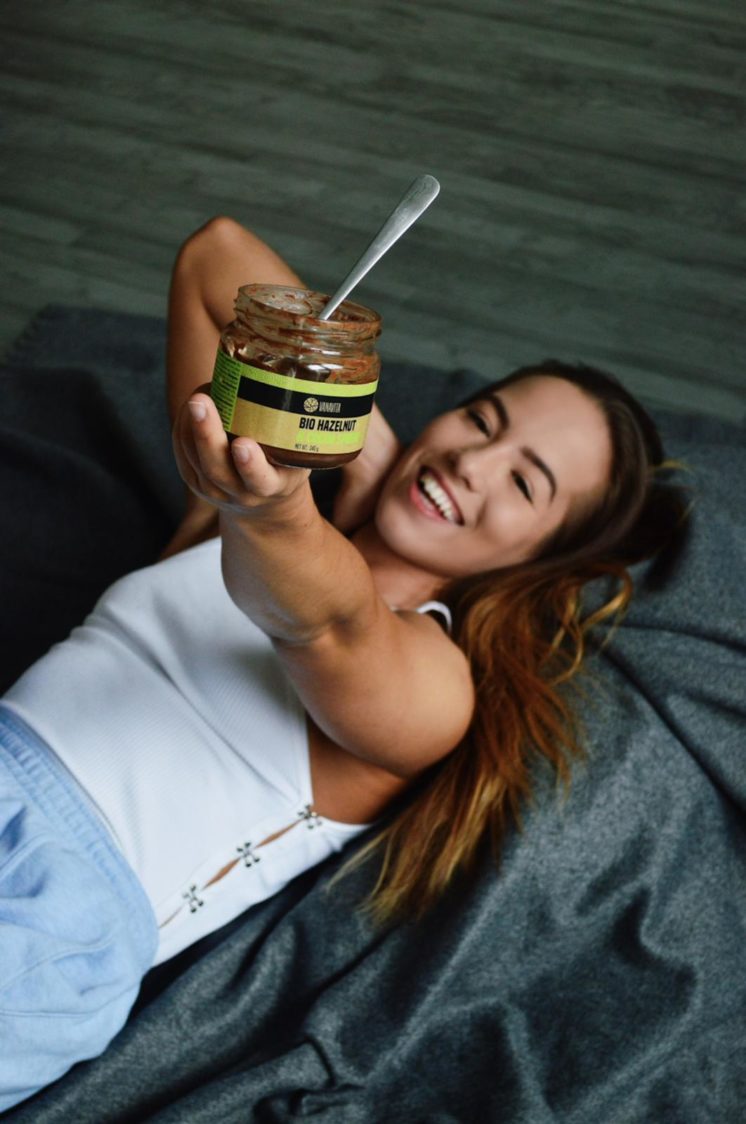
4. Flavoured nut butters
This group includes creams and spreads that contain a number of ingredients other than nuts. It may well be that instead of a high-quality nut butter with many benefits, you suddenly have a popular hazelnut cream with chocolate on the table, which contains only 13% nuts.
The rest is sugar, palm oil, milk powder, cocoa, salt and other additives. The nutritional value of this mix is quite different from that of 100% butter. They are usually higher in sugars, saturated fats, salt and lack vitamins and minerals.
In particular, you should consider the difference in the content of simple sugars to be very important, as they are classified as a risk nutrient and should be limited to 10% of total energy intake in a healthy diet. By eating a greater quantity of these sweet spreads, you could exceed this daily intake. [2-4]
- 100 g of chocolate spread (Nutella) contains 54 g of sugar.
- 100 g of 100% nut butter contains 3-5 g of sugar.
If you still want to diversify your diet with a sweet spread, you can find more suitable options with a more favourable ingredients profile. Examples choose chocolate spread with 64% hazelnuts or cashew cream with lyophilized strawberries.
The most popular nut butters and their properties
Each of us probably has a favourite among the nut butters that must never be missing in the pantry. They differ in taste, but also in their nutrient content, which depends on the type of nuts used. But what they have in common is their healthy fat content, which includes monounsaturated (MUFA) and polyunsaturated (PUFA) fatty acids, including essential omega 3 fatty acids. These fats are associated with positive effects on heart, vascular and brain health. Nuts have an average 50% fat content, so they are regarded as a valuable source of this nutrient. [15, 16]
You may have also heard that nut butters are rich in protein. The type of nut influences the amount of this nutrient, which is why different products differ from one another. But the problem is that these are plant proteins, which, unlike animal proteins, do not contain all the essential amino acids in the optimal ratio. For example, they often lack lysine, methionine or cysteine.
To acquire at least 27 g of protein from peanut butter, it would mean eating at least 100 g of peanut cream. At the same time, you would also be taking in almost 50 g of fat and 600 calories, which would be less than ideal. Ultimately, such a large portion of fat could also give you stomach problems. Thus, it is more reasonable to consider nut butters as a source of fat rather than protein. [17]
1. Peanut butter
Peanut butter is undoubtedly the most popular and most used of all the creams. It cheekily reigns supreme over all nut butters, even though peanuts are technically a legume. Ultimately, it’s all about taste, ingredients and use. And in these areas, peanut butter has convinced us that it has an honourable place here.
Peanut butter was popularised as early as 1895 by the American doctor John Harvey Kellogg. He produced it for his patients who had bad teeth and needed to take in high amounts of energy and protein. The product’s reputation soon spread across the continent. According to statistics, it can now be found in 94% of American households, where it is most often used to make the famous PB&J (peanut butter + jam) sandwich. However, it is not always the product with 100% peanut content that has great nutritional properties. [5]
Nutritional profile and benefits of peanut butter
- It stands out among other nut creams for its protein content, which ranges between 25-27 g per 100g.
It contains healthy fats in the form of monounsaturated (MUFA) and polyunsaturated (PUFA) fatty acids.
- Thanks to its high fibre content, it has great satiating effects. Even in small quantities it can fight off the feeling of an empty stomach. So as long as you don’t quickly eat one spoonful after another one, you probably won’t eat a large amount of this butter at any one time.
- It contains vitamins B3 and B6, which support the proper functioning of the nervous system. In addition, it contains vitamin B9 (folic acid), which is important for the growth of germ tissues during pregnancy and also contributes to normal blood formation.
- It is also rich in vitamin E, which is an antioxidant that helps protect cells from oxidative stress.
- It also contains a number of minerals. Magnesium, for example, promotes proper muscle function and helps to reduce fatigue. It is thus important for both athletes and the non-sporting population. Zinc in turn supports proper immune function and is important for maintaining normal testosterone levels in the blood. It also contains iron, which contributes to the normal production of red blood cells and haemoglobin. Deficiencies of this mineral are experienced, for example, by women during menstruation, when they lose a greater amount of blood.
- It also boasts choline, from which the neurotransmitter acetylcholine is formed in the body. This is important for learning and other brain functions. So, if you’re preparing for an important exam, you have an excuse to snack. Just make sure you don’t forget to close the lid in time so as not to eat the whole jar while you’re concentrating. [6]
Nutritional values of peanut butter
Energy value | Fats | Carbohydrates | Protein | Fibre |
|---|---|---|---|---|
| 596 kcal | 46 g | 14 g | 27 g | 9.1 g |
Recipes using peanut butter
Thanks to its taste, peanut butter is excellent in both sweet and savoury dishes. You can use it for spreading on pastries, garnishing porridge and pancakes, flavouring smoothies, in desserts, but also for preparing a salty peanut sauce, which is an integral part of Asian dishes. Combined with an apple or banana, it creates a great combo for replenishing energy at any time of the day.
You will find inspiration in these recipes:
- Peanut Putter & Strawberry Jelly Bars
- Quick Peanut Butter Chocolate Tartlets
- No Bake Peanut Balls in Chocolate
- Indonesian Chicken Satay with Peanut Sauce
If you want to learn more about peanut butter, read our article Peanut Butter: How to Pick the Best Peanut Butter, and What Impact It Has on Your Health?

2. Almond butter
Almond butter probably has as long history as does peanut butter. Many people were allergic to it, so they discovered a great alternative in almond cream. Since then, however, it has built its own reputation and so many fans that few would call it a peanut butter substitute anymore. Its growing popularity is due mainly to its taste and nutritional properties. Traditionally made from unshelled almonds, it retains its natural bitter-sweet flavour as well as the maximum amount of important nutrients. [7]
Nutritional profile and benefits of almond butter
- It wins the gold medal in the category of fibre content. Due to the fact that it is mixed with its peel, it has the highest fibre content of all the butters on this list. It can therefore fill you up even with a small serving.
- Compared to other nut creams, it has fewer carbohydrates. That’s why it’s also popular among fans of low-carb, keto and other types of low-carb diets.
- It is rich in unsaturated omega 6 fatty acids as well as rare omega 3 fatty acids, which are important for brain, heart and eye health.
- It is rich in the vitamins B2 and B3 which contribute to normal energy metabolism, during which energy is released and utilised.
- It also contains vitamin B9 (folic acid) and vitamin E, which has antioxidant effects.
- It is also one of the few nuts that boasts calcium, which is needed for bones and teeth.
- We can’t forget to mention magnesium and potassium, which are important for proper muscle function. This butter is made for athletes and active individuals. [4, 8]
Nutritional values of almond butter
Energy value | Fats | Carbohydrates | Protein | Fibre |
|---|---|---|---|---|
| 650 kcal | 56 g | 7 g | 25 g | 12 g |
Recipes using almond butter
Almond butter will flavour your porridge, pancakes and smoothies beautifully and it is also great on crusty bread. Its bittersweet taste also makes it suitable for savoury cream sauces or pesto. You won’t go wrong if you make it into a dip for dipping carrot pieces or other vegetables or fruit.
You will find inspiration in these recipes:
- Cinnamon French Toast with Banana and Nut Butter
- Vegan Almond Biscuits with Choc Bits
- 3Bit Caramel Pudding Cake with Cream Cheese Frosting
You can read more interesting information about almonds in our article Almonds: Everything You Need to Know.
You might be interested in these products:
3. Cashew butter
If you’ve ever tasted cashew butter, you’ll agree that it has the creamiest consistency. When you add the naturally sweet taste, it’s not hard to guess why it’s so popular. An interesting fact is that back during the Cold War, cashew nut cream was part of the rescue packs carried by American soldiers. Nowadays, it no longer primarily serves as a rescue from hunger, but makes meals more tasty and nutritionally rich. [9]
Nutritional profile and benefits of cashew butter
- Compared to other nut butters, it has a slightly higher carbohydrate content. But you don’t have to worry about that. These are mostly complex carbohydrates, which are part of a healthy diet and act as a slow-release source of energy.
- Like peanuts, cashews do not lack in MUFA and PUFA unsaturated fatty acids, which according to studies have a beneficial effect on blood cholesterol levels.
- Its nutritional profile boasts the presence of vitamin K, which is important for proper blood clotting and normal bone health.
- It also contains copper, which supports proper functioning of the immune system and is also important for normal pigmentation (colouring) of hair and skin.
- In addition, selenium helps maintain healthy hair and nails, making it ideal for anyone who cares about their health and beauty.
- It also contains manganese, which is one of the antioxidants that protect cells from oxidative stress. [10, 18]
Nutritional values of cashew butter
Energy value | Fats | Carbohydrates | Protein | Fibre |
|---|---|---|---|---|
| 574 kcal | 46 g | 33 g | 15 g | 3 g |
Recipes using cashew butter
Thanks to its irresistibly creamy consistency, it is perfect for the preparation of sauces, in which it also works well as a substitute for cream. It also tastes great in salad dressings, desserts, porridges and we should mention the perfect combination with a banana.
You will find inspiration in these recipes:
- Pasta Salad with Cashew Dressing
- Sweet Potato Bowl with Tofu and Cashew Dressing
- Homemade Vegan Toffifee
If you want to learn more about cashew nuts, you can find more interesting information in our article Cashew Nuts: Everything You Need to Know.
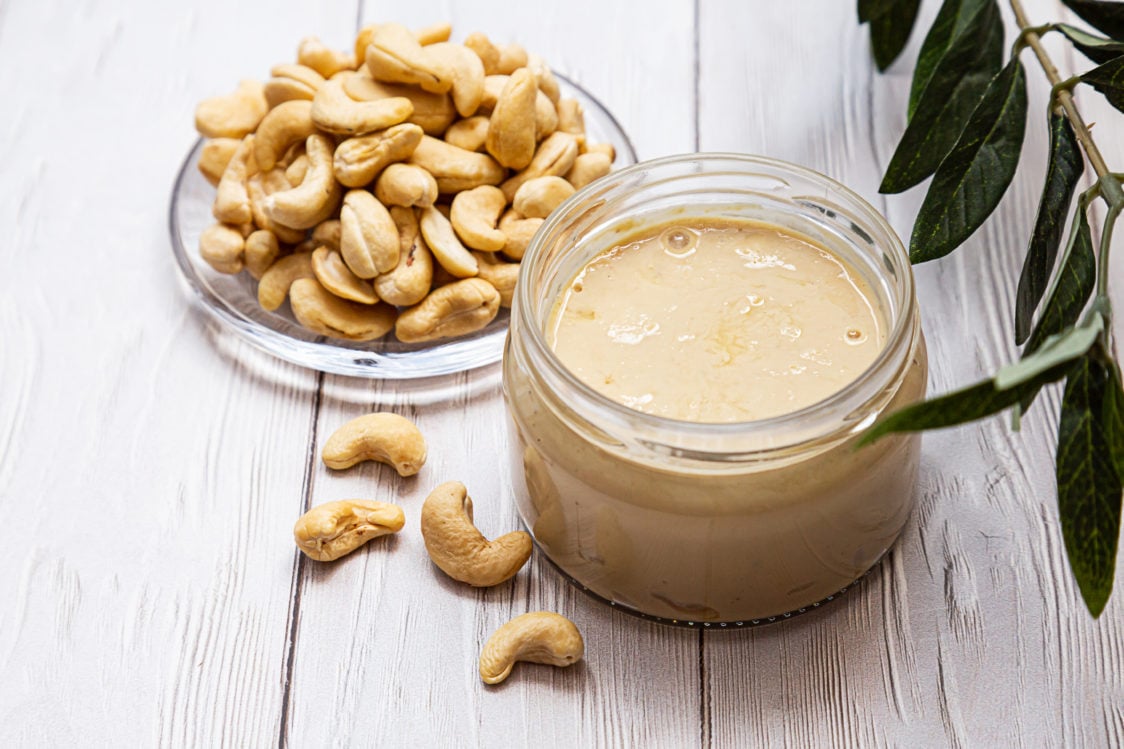
4. Hazelnut butter
The taste of hazelnut butter evokes childhood memories for many of us, as we associate it with Nutella chocolate spread or the iconic Ferrero Rocher. These sweets are probably behind the popularisation of hazelnut cream, which can now be bought without sugar and other flavourings. This allows to enjoy the naturally sweet taste of hazelnuts while getting the maximum nutrients. [11]
Nutritional profile and benefits of hazelnuts
- In terms of macronutrient ratio (protein, carbohydrate and fat), it is the most similar to cashew butter.
- It also contains healthy MUFA and PUFA unsaturated fats.
- It boasts vitamin B1, which supports normal heart and mental function.
- It contains vitamin B6, B9 and magnesium to reduce fatigue and exhaustion. Therefore, reaching for a spoonful of hazelnut butter during busy days certainly won’t do any harm.
It also contains antioxidant substances in the form of vitamin E and manganese.
- It is also a source of vitamin K, which is important for healthy bones and proper blood clotting.
- It also contains iron, which helps to support cognitive functions such as memory, thinking and concentration. This makes it suitable for people who engage in creative and otherwise mentally demanding activities. In addition, the contained copper supports the normal transfer of iron throughout the body.
- Last but not least, phosphorus helps maintain normal teeth and bones. [12]
Nutritional values of hazelnut butter
Energy value | Fats | Carbohydrates | Protein | Fibre |
|---|---|---|---|---|
| 571 kcal | 50 g | 28.6 g | 17.9 g | 3.6 g |
Recipes using hazelnut butter
Hazelnut butter perfectly flavours desserts, cereal, pancakes or aromatic homemade granola. Combined with cocoa, you can also use it to make a healthy chocolate spread that is delicious on baked goods. It also tastes great in Christmas sweets and makes a perfect pair with strawberries.
You will find inspiration in these recipes:
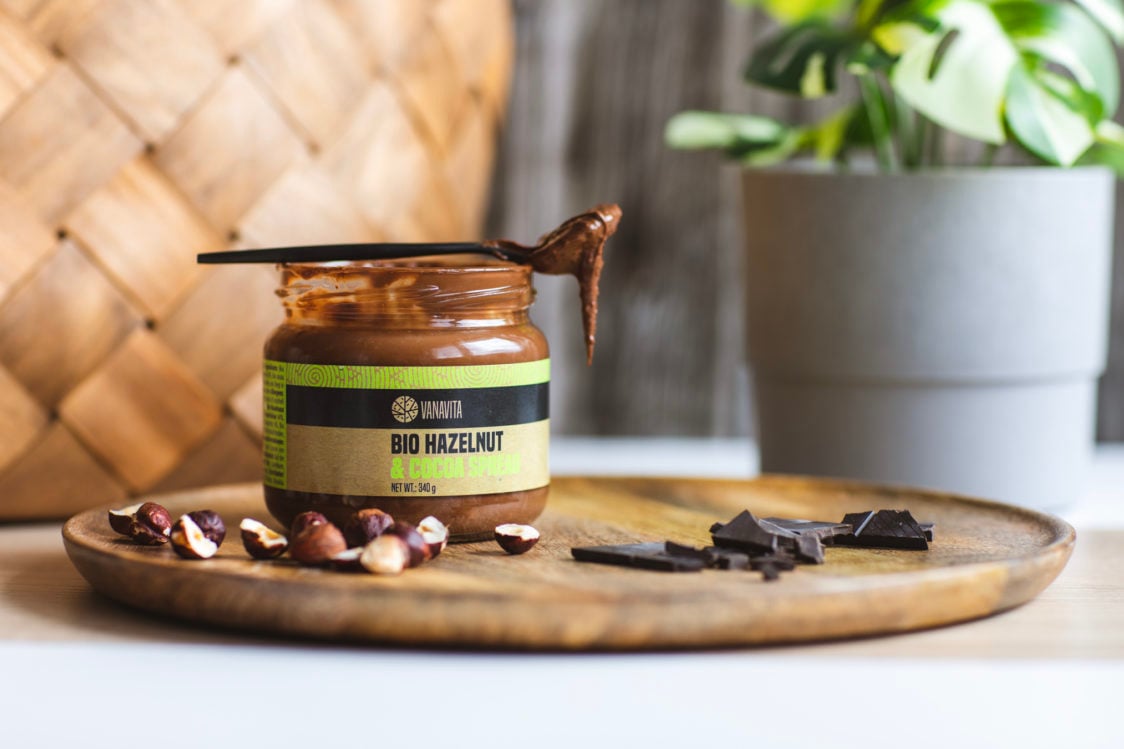
5. Pistachio butter
Historically, pistachios were considered a rare nut, reserved for nobility and high-ranking officials. Legend has it that the Queen of Sheba even forbade the common people to grow them, claiming that they were exclusively royal food. Fortunately, those days are over and everyone can enjoy the exquisite taste of these green nuts in the form of a nut butter. It is also becoming increasingly popular thanks to its excellent nutritional profile, smooth consistency and wide range of uses in the kitchen. [13]
Nutritional profile and benefits of pistachio butter
- It boasts a higher protein content that rivals even peanut butter.
It is rich in fibre, which contributes to a feeling of satiety.
- It contains about 50% fat, most of which are beneficial unsaturated fatty acids (MUFA, PUFA), which are often lacking in the diet of people living in inland areas.
- Among the micronutrients, it contains vitamins B1 and B6, which support normal mental activity, including the ability to learn, think and concentrate.
- It is a source of vitamin K, which contributes to proper blood clotting and helps maintain healthy bones.
- The contained copper supports the normal function of the nervous system, which controls the activity of all organs in the body.
- Thanks to magnesium, it can help reduce fatigue and exhaustion.
- The minerals manganese and phosphorus are important for energy metabolism, during which energy is released and utilised.
- It also has contains choline, which is important for proper brain function, making this butter another great candidate for smart study snacks. [14]
Nutritional values of pistachio butter
Energy value | Fats | Carbohydrates | Protein | Fibre |
|---|---|---|---|---|
| 594 kcal | 50 g | 21.9 g | 25 g | 9.4 g |
Recipes using pistachio butter
The advantage of pistachio butter is its slightly sweet taste, which is great for both sweet and savoury dishes. It also lends its unusual greenish colour to dishes. It is suitable for muffin batters, cakes and other desserts, as well as enriching savoury pastries. It can also be added to salad dressings and used to make homemade pistachio ice cream.
You will find inspiration in these recipes:
- Non-Traditional Pistachio Cake with Ricotta Cream, Protein and Pistachio Butter
- Pistachio Baklava with Walnuts
- Bundt Cake Combining the Perfect Taste of Lemon and Pistachios
Comparison of nutritional values of nut butters
In this table, we’ve summarised the nutritional values of popular nut butters so you can quickly find the one that best suits your needs.
| Nut butter | Energy value | Fats | Carbohydrates | Protein | Fibre |
|---|---|---|---|---|---|
Peanut butter | 596 kcal | 46 g | 14 g | 27 g | 9.1 g |
Almond butter | 650 kcal | 56 g | 7 g | 25 g | 12 g |
| Cashew butter | 574 kcal | 46 g | 33 g | 15 g | 3 g |
Hazelnut butter | 571 kcal | 50 g | 28.6 g | 17.6 g | 3.6 g |
Pistachio butter | 594 kcal | 50 g | 21.9 g | 25 g | 9.4 g |
How to store nut butter?
Do you put your nut butter in the fridge or keep it in the cupboard? Both of these options are not wrong, but each has its pros and cons. In the cold environment of the fridge, the butter can solidify due to its high fat content, which will make it difficult to spread. In warm porridge, however, it will melt nicely. The cold also extends its shelf life, making it easier to maintain its quality and it is better protected against rancidity.
If you store the butter outside the fridge, put it in a closed cabinet where it is protected from the heat and sunlight. It will stay nice and runny and easier to work with when preparing food. However, be aware that at room temperature, the oil layer that builds up on top of the butter may separate. Don’t worry about that though, just stir the butter well and you’re fine again. [19]
Thanks to proper storage, the nut butter will last for several months. That is, if you don’t eat it first.
If you want to learn how to store other foods, read our article How to Store Food Properly to Make It Last as Long as Possible.
Nut butters for weight loss and weight gain
Nut butters have a function in your diet both in gaining muscle mass and during weight loss. Because they boast a high energy density (high calorie content for a small amount of food), they can effectively help with increasing caloric intake. Just add a big spoonful of almond butter to your meal and you’ll instantly get 200 extra kcal. Nut butters can be easily incorporated into breakfasts, snacks, shakes and main meals.
When losing weight, it is better to watch the amount of nut butter you eat for the same reason, but even in this case you don’t have to give it up completely. It can help you replenish healthy fats, which are also important for weight loss. In addition, it can also satisfy your sweet tooth when combined with fruit, for example. And if you’re looking for a low-fat option, try powdered peanut butter, which contains just 1.5 g of fat per serving.
In addition, nuts and nut butters are also associated with healthy weight and have a positive effect on weight loss, according to studies. Even so, be sure to use them in moderation and be sure to count each spoonful conscientiously in your daily calorie intake. [15]
What should you remember?
Nut butters are carriers of healthy fats, vegetable proteins, vitamins, minerals and also taste great. But if you want to get the best out of them, you shouldn’t forget to check the ingredients. 100% nut creams are ideal, but protein or flavoured nut butters with a minimum of added substances can also be used. You can decide whether to add peanut, almond or cashew butter to your diet based on your taste preferences and the nutritional properties mentioned above. In any case, you shouldn’t overdo it with butters because of their high caloric value.
Do you have nut butter lovers among your friends? Share this article to help them learn some valuable information.
[1] How Nut and Seed Butters Are Processed. – https://www.ift.org/news-and-publications/food-technology-magazine/issues/2016/november/columns/processing-how-nut-and-seed-butters-are-processed
[2] WHO. Healthy diet. – https://www.who.int/news-room/fact-sheets/detail/healthy-diet
[3] Nutella®. – https://www.nutella.com/cz/cs/vyrobky/nutella
[4] FoodData Central. – https://fdc.nal.usda.gov/fdc-app.html#/food-details/1100559/nutrients
[5] HuffPost . Who Really Invented Peanut Butter?– https://www.huffpost.com/entry/peanut-butter-history_n_1222585
[6] Peanut butter, vitamin and mineral fortified, smooth nutrition facts and analysis. – https://www.nutritionvalue.org/Peanut_butter%2C_vitamin_and_mineral_fortified%2C_smooth_nutritional_value.html
[7] Almond Butter: History, Flavor, Benefits, Uses. – https://www.spiceography.com/almond-butter/
[8] Nuts, almond butter, plain, without salt addend. – https://nutritiondata.self.com/facts/nut-and-seed-products/3153/2
[9] About: Cashew bitter– https://dbpedia.org/page/Cashew_butter
[10] Cashew butter nutrition facts and analysis. – https://www.nutritionvalue.org/Cashew_butter_42201000_nutritional_value.html
[11] Group, A. (History of Hazel Nut Spread. – https://acitgroup.com.au/history-of-hazel-nut-spread/
[12] Nuts, hazelnuts or filberts Nutrition Facts & Calories. – https://nutritiondata.self.com/facts/nut-and-seed-products/3116/2
[13] The Green Nut: A brief history of the Pistachio. – https://www.joinrassa.com/articles/the-green-nut-a-brief-history-of-the-pistachio
[14] Nuts, pistachio nuts, dry roasted, without salt added Nutrition Facts & Calories. – https://nutritiondata.self.com/facts/nut-and-seed-products/3136/2
[15] Going Nuts—For Nut and Seed Butters, That Is. – https://www.todaysdietitian.com/newarchives/090313p64.shtml
[16] Ros, E. Health Benefits of Nut Consumption. – https://doi.org/10.3390/nu2070652
[17] Venkatachalam, M., & Sathe, S. K. – https://doi.org/10.1021/jf0606959
[18] The Nutrition Source. Types of Fat. – https://www.hsph.harvard.edu/nutritionsource/what-should-you-eat/fats-and-cholesterol/types-of-fat/
[19] HuffPost. Do You REALLY Need To Refrigerate Nut Butter? – https://www.huffpost.com/entry/do-you-need-to-refrigerate-nut-butter_l_5eb2bd05c5b619cb5f00aae2

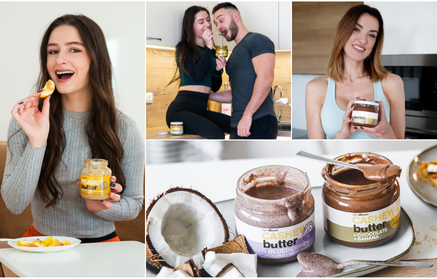
Add a comment